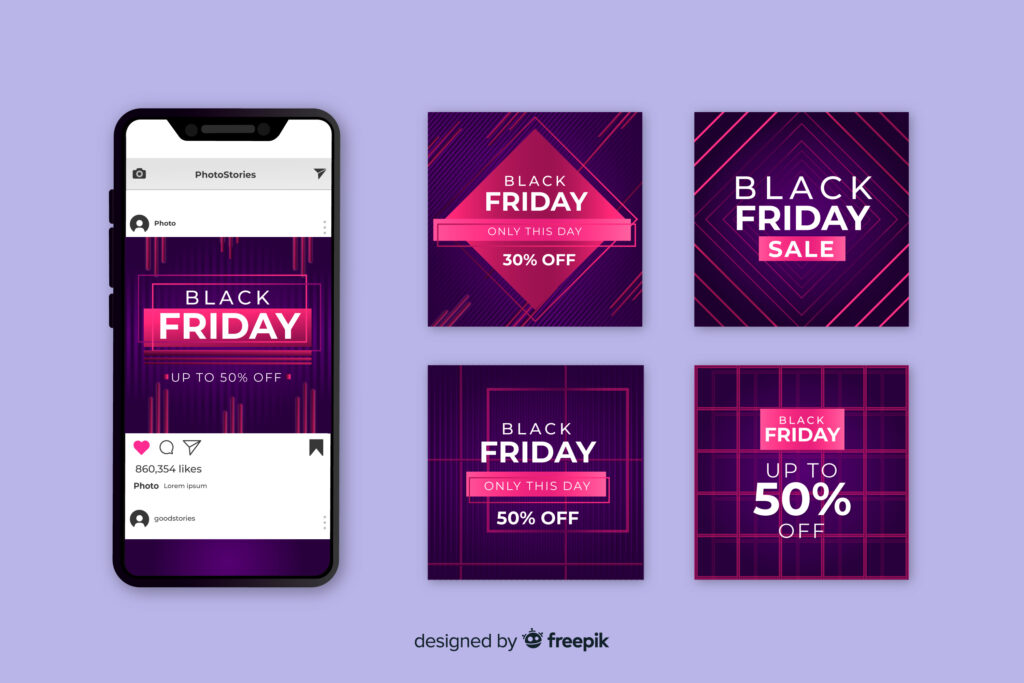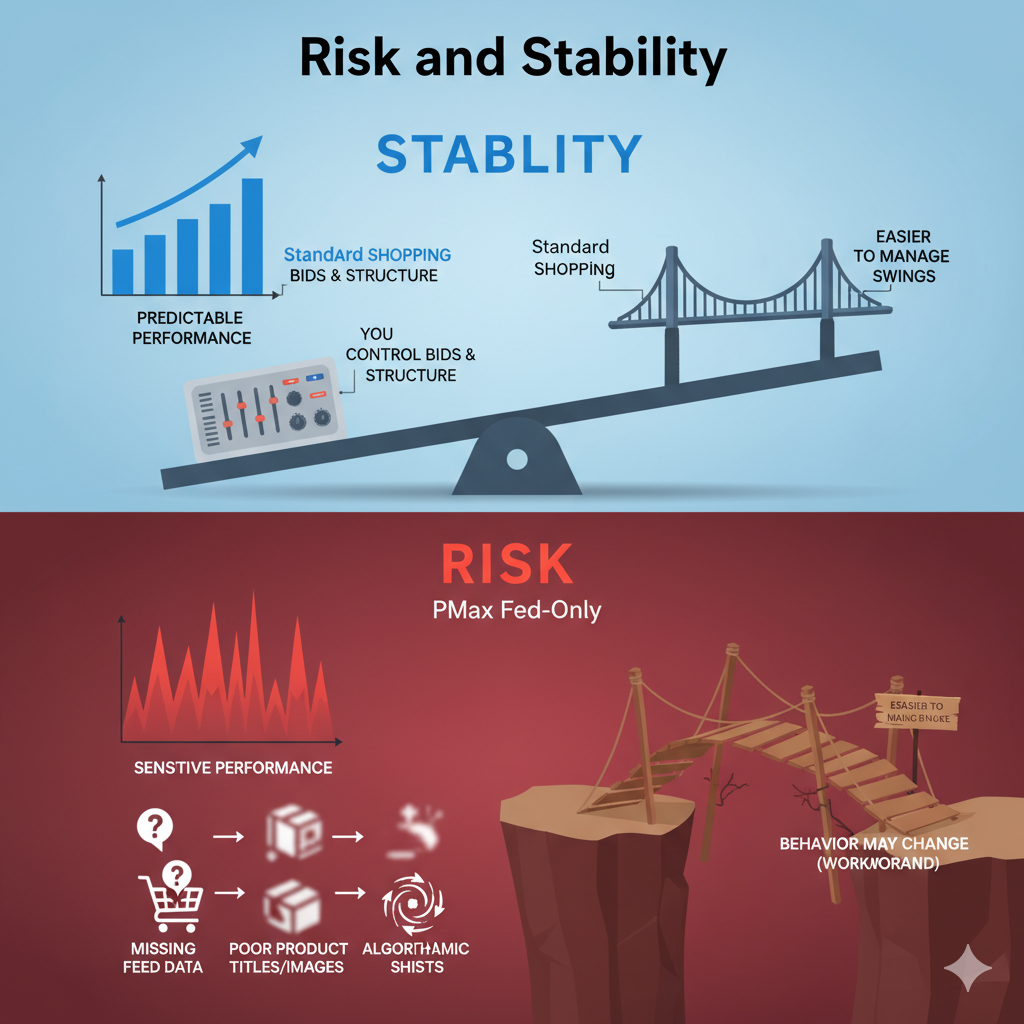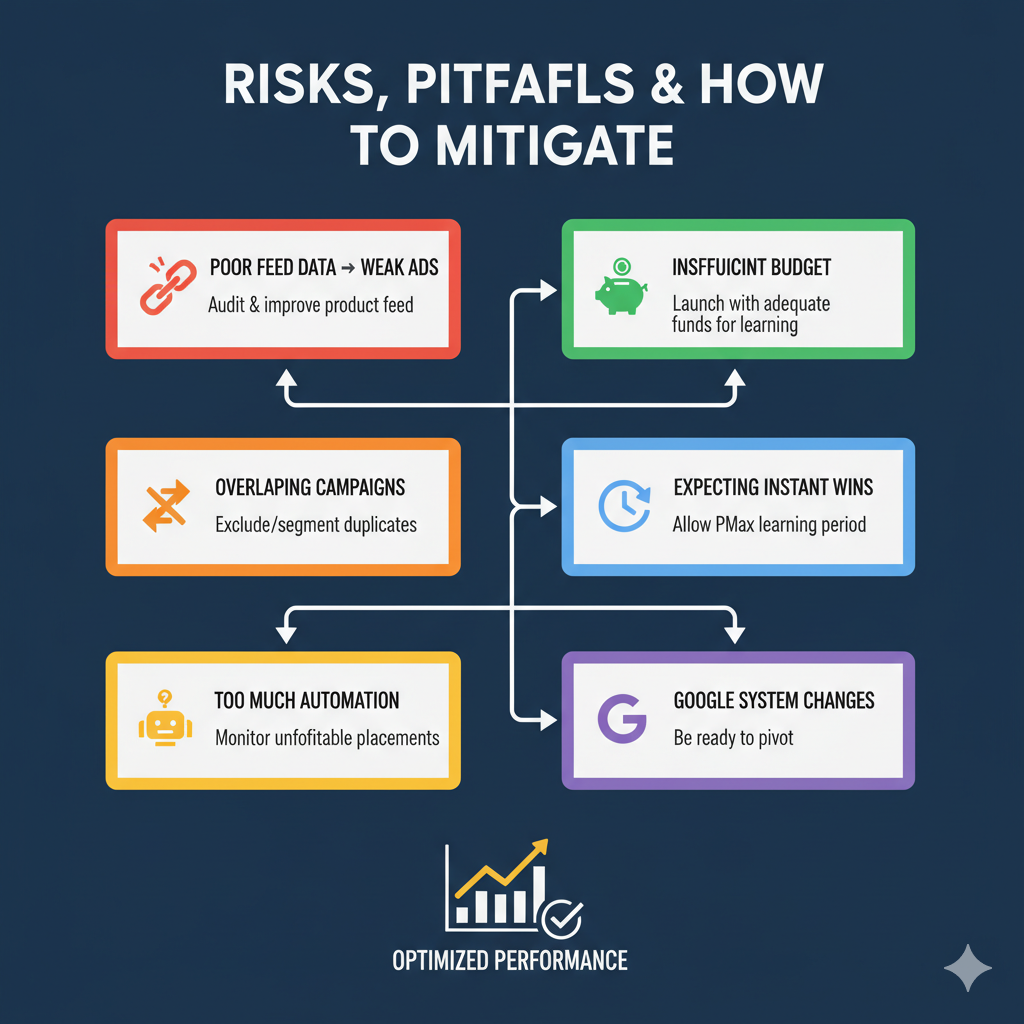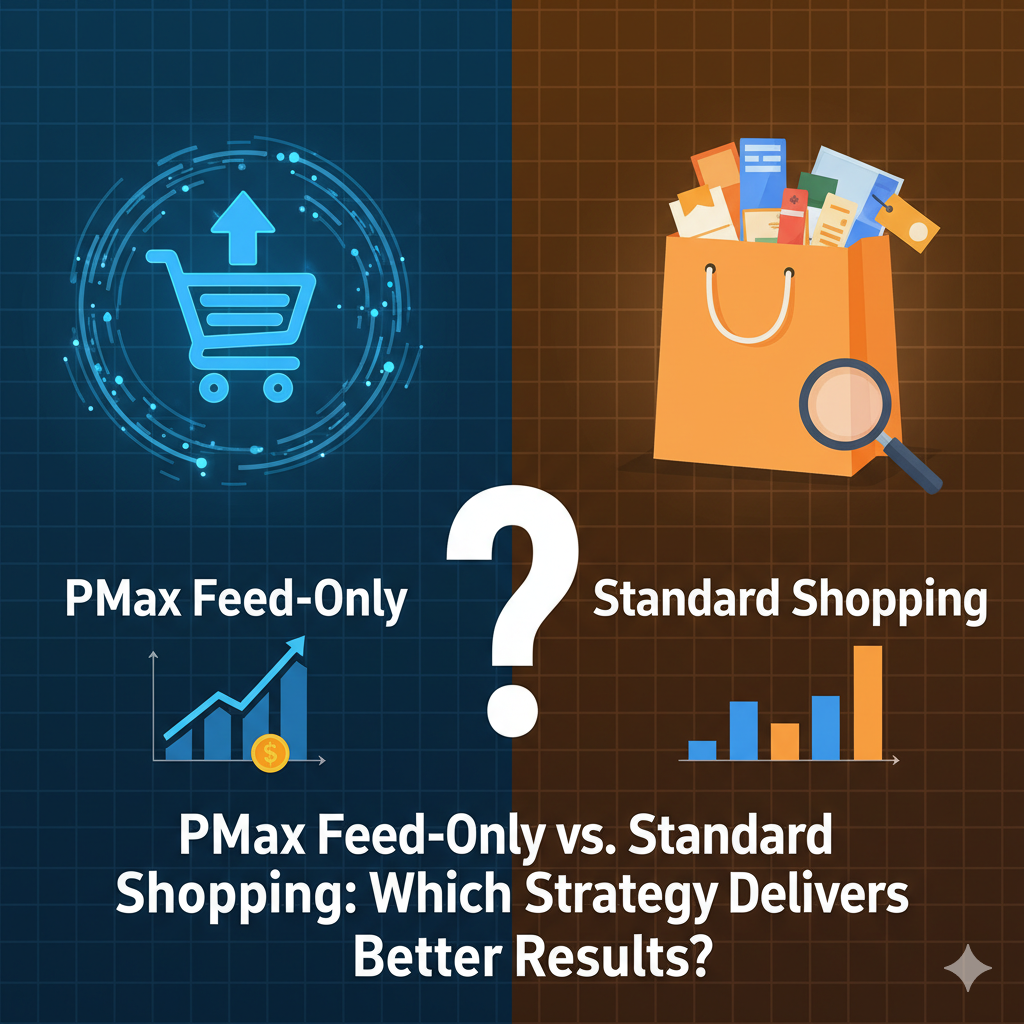In Google Ads, choosing between a PMax feed-only campaign and a Standard Shopping (also called “Standard Shopping campaign”) setup can make or break your outcomes. Each approach has its strengths, trade-offs, and ideal use cases.
In this article, I’ll walk through how each works, compare their differences, explore when to use which, and offer tips to get the best results.
What Is Standard Shopping?
A Standard Shopping campaign is Google’s more traditional shopping ads setup. You link your Google Merchant Center product feed to Google Ads, group products into campaigns and ad groups, set bids, and let Google display those products in search results, Google Shopping tab, and sometimes search partner sites.
You maintain control over bids, negative keywords, priority settings, and campaign structure.
Key attributes of Standard Shopping:
- Ad creative is generated from feed data (titles, images, descriptions)
- You control campaign structure: product groups, bids, negatives
- Placements are limited to shopping and search partner networks (not Display, YouTube, etc.)
- Reporting is more granular with visibility into search terms, etc.
Standard Shopping gives hands-on control over how products show, who sees them (via negative keywords, bid adjustments), and how budget is allocated.
What Is PMax Feed-Only?
PMax, or Performance Max, is Google’s newer campaign type designed to unify multiple ad channels (Search, Display, YouTube, Discover, Gmail, etc.) under one campaign leveraging automation and machine learning.
A feed-only PMax campaign is a variant where you essentially disable or omit additional creative assets (texts, images, videos) and rely solely on your product feed from Merchant Center.
It forces Google to use your product feed as the primary driver of ad creation and delivery, with fewer creative inputs. In effect, it behaves more like a shopping-focused campaign but still resides under PMax’s optimization logic.
Because it’s under PMax, you still benefit from automated bidding, audience signals, and channel optimization. But without assets, the creative diversity is limited, and the campaign often emphasizes shopping placements and dynamic remarketing.

Key Differences: PMax Feed-Only vs Standard Shopping
Reach and Ad Channels
Standard Shopping focuses on Shopping placements and search partner sites. It does not inherently show ads on Display, YouTube, Gmail, etc.
PMax feed-only, while more restricted than full PMax, can still benefit from Google deciding to show your product ads or similar dynamic formats across broader channels, depending on settings and Google’s interpretation.
Automation vs Control
Standard Shopping gives more manual control: you pick bids, adjust priorities, set negative keywords, and segment by product groups.
PMax feed-only leans heavily on automation. The algorithm decides where and to whom to serve your ads based on signals, which means you sacrifice some control but gain simplicity and machine learning advantages.
Creative Assets and Variation
With Standard Shopping, the creative options are limited to what’s in the feed. You don’t supply text, images, or videos, Google builds the ad from product attributes.
In feed-only PMax, you also forgo extra assets, so your ads depend entirely on feed data. But PMax’s engine still optimizes placements, bidding, and audiences.
Optimization and Learning
Standard Shopping requires you to manually test bid strategies, negative keywords, and product grouping. You’re the driver.
Feed-only PMax allows the system’s algorithms to test and find what works, price sensitivity, audience segments, and channel mixes, based on the feed inputs. This can accelerate learning but sometimes lead to less transparency.
Reporting and Transparency
Standard Shopping offers visibility into search terms, negative keywords, and more granular metrics.
PMax feed-only has less transparency in how Google allocates spend across channels and which placements led to conversions. Some metrics (e.g. “engaged view” conversions) may complicate attribution.
Risk and Stability
Standard Shopping is more predictable. Because you control bids and structure, performance swings are easier to manage.
PMax feed-only is sensitive to feed quality, signal inputs, and algorithmic shifts. Missing feed data or poor product titles/images hurt performance more. Also, because it’s a workaround (no official Google product type called “feed-only PMax”), it may change in behavior over time.

When to Use Standard Shopping vs PMax Feed-Only
Use Standard Shopping when:
- You want granular control over bids, negative keywords, product segmentation, and campaign structure.
- You have a smaller catalog or a few high-margin products you want to manage carefully.
- You want clarity in reporting and attribution, knowing which search queries drove performance.
- You prefer a stable, predictable campaign that isn’t entirely dependent on automation.
Use PMax Feed-Only when:
- You want simplicity and reduced management overhead while still leveraging Google’s AI.
- Your catalog is larger, and managing product-level structure is cumbersome.
- You have confidence in feed quality (titles, descriptions, images) and minimal need for creative assets.
- You want to capture incremental reach or let Google algorithmically expand placements.
- You are already running standard campaigns and want to “let Google handle the heavy lifting” for certain products.
In practice, many advertisers run both: use Standard Shopping for control and product-level fine-tuning, and run a feed-only PMax in parallel to capture additional volume and let algorithms find opportunities.
Strategic Setup and Tips for PMax Feed-Only & Standard Shopping
1. Optimize Your Product Feed
Since feed data is your only creative source in a feed-only PMax, every attribute matters: titles, descriptions, images, custom labels, and product categories. Poor feed quality will directly hurt ad performance.
2. Segment Products Intelligently
Group bestsellers, high-margin items, or seasonal products separately.
In Standard Shopping, this allows tailored bids. In PMax feed-only, you can create separate campaigns or asset groups to let the algorithm focus on subsets.
3. Use Audience Signals
In PMax feed-only, include audience hints, remarketing lists, high-intent users, and similar audiences. These guide the algorithm in prioritizing ad delivery.
While you can’t fully control targeting, providing signals improves efficiency.
4. Monitor Overlap and Competition
If the same products are in both Standard Shopping and PMax feed-only campaigns, they might compete. Watch the performance. You might need to exclude products from one or adjust budgets to reduce cannibalization.

5. Adjust Budgets Carefully
Allocate budgets based on performance. If PMax feed-only begins outperforming, shift the budget gradually. But don’t panic; algorithms may need time to stabilize.
6. Test Incrementally
Start with a limited budget on PMax feed-only. Let it run alongside Standard Shopping before shifting large portions of your budget. This gives comparative data to decide what works.
7. Watch for Changes in Google Behavior
The behavior of PMax feed-only may shift. Google has been evolving how auto-generated assets or placements work. Stay alert for changes.
Sample Scenario & Comparison
Imagine an online store with 100 products. They run:
- Standard Shopping campaigns structured into categories (e.g., Electronics, Accessories)
- A test PMax feed-only campaign with the same product feed
Over 30 days, they notice:
- Standard Shopping yields steady conversions and manageable ROAS
- PMax feed-only captures incremental conversions, especially from dynamic remarketing and shopping audiences they hadn’t reached
- Sometimes, PMax feed-only uses the budget on low-margin products unless filtered
In such a scenario, the advertiser might:
- Continue Standard Shopping on core items
- Let PMax feed-only run on secondary or broader catalog items
- Exclude very low-margin items in feed-only campaign
- Monitor overlap and adjust gradually
This hybrid allows balance: control where it matters, automation where it helps.
Risks, Pitfalls & How to Mitigate
- Poor feed data leads to weak ads. Always audit and improve your product feed first.
- Overlapping campaigns cause internal competition. Exclude or segment duplicates.
- Too much reliance on automation can lead to wasted spend on unprofitable placements.
- Insufficient budget prevents algorithms from learning; avoid launching with too low a budget.
- Expecting instant wins—PMax feed-only needs a learning period. Don’t judge performance too soon.
- Changes in Google’s system could alter how feed-only behaves. Be ready to pivot.

Final Thoughts
There’s no one-size-fits-all answer between PMax feed-only and Standard Shopping. Each serves a role:
- Use Standard Shopping when you need control, transparency, and precise management.
- Use PMax feed-only when you prefer automation, want to scale reach, and trust your feed quality.
The best approach often combines both: run Standard Shopping for your high-stakes items and use feed-only PMax to capture incremental volume and leverage smart optimizations. Over time, monitor which campaign types deliver better ROAS, conversions, and stability, and adapt accordingly.
Want me to also provide real-world case studies with data (ROAS numbers etc.) that illustrate which approach has worked better for other businesses?
Popular Questions and the answers
What is a PMax feed-only campaign?
A PMax feed-only campaign is a Performance Max setup that relies solely on your product feed from Google Merchant Center, without adding extra assets like headlines, descriptions, or videos.
It focuses primarily on Shopping-style placements but benefits from PMax’s automation and machine learning.
How is PMax feed-only different from Standard Shopping?
Standard Shopping gives advertisers full control over bids, keywords, and campaign structure, while PMax feed-only automates targeting and bidding.
The main difference lies in control versus automation. Standard Shopping offers transparency, whereas PMax feed-only relies on Google’s algorithms to decide where and when to show ads.
Which performs better: PMax feed-only or Standard Shopping?
Performance varies by business type and feed quality. Many advertisers see stronger reach and conversion rates with PMax feed-only due to automation, while Standard Shopping provides more predictable and consistent results when managed manually. Testing both often delivers the clearest insights.
Does PMax feed-only require creative assets?
No. PMax feed-only uses your product feed exclusively, images, titles, and descriptions from the Merchant Center. This makes it ideal for advertisers who want a simpler setup or prefer not to create additional ad assets.
Can I run both PMax feed-only and Standard Shopping together?
Yes, you can run both simultaneously, but it’s important to manage overlap. Exclude certain products from one campaign to prevent internal competition and to get more accurate performance insights for each type.
Is reporting better in Standard Shopping or PMax feed-only?
Standard Shopping provides more detailed reports, including search terms and product-level performance. PMax feed-only offers limited transparency, as Google consolidates data across channels. Advertisers who need granular insights often prefer Standard Shopping for analysis.
Which campaign type is best for beginners?
For beginners, PMax feed-only can be easier to manage because Google handles most optimization tasks automatically. However, those who want to learn campaign management fundamentals and understand where the budget is going might benefit more from starting with Standard Shopping.




